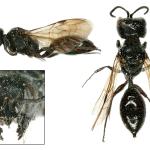Cemonus dentatus PUTON 1871; Cemonus shuckardi MORAWITZ 1864; Pemphredon tenax FOX 1829;
The genus Pemphredon has been the subject of much taxonomic debate regarding the aggregation or splitting of species pairs. This particular species has been subjected to more grammatical than taxonomic uncertainty, with Richards (1980) and Bitsch et al. (2001) referring to it as inornata Say, whilst Lomholdt (1984) opts for inornatus Say.
Richards (1980) considered this species to be common and found throughout England, Wales, southern Scotland and Ireland. Data collated for this atlas suggest that it is rather sparse in Scotland and has a very limited distribution in Ireland, although this may reflect relative lack of recording.
It is widespread in Scandinavia, approaching the Arctic Circle (Lomholdt, 1984) and is found across the Palaearctic to the Far East. It is also found in North America, Canada and Mexico (Bitsch et al. 2001).
This species is not regarded as being scarce or threatened.
Presumably occuring in a wide variety of habitats, wherever favoured nesting sites are found. These include areas of reed, scrub, woodland and gardens.
Richards (1980) gives May to September. Lomholdt (1984) suggests that a partial second brood may sometimes occur, with individuals active in mid-September.
Lomholdt (1984) records the prey as being various aphids (Hemiptera: Aphididae).
Nests in hollow stems, branches and old wood but also the cigar galls formed on common reed by the chloropid fly Lipara lucens Meigen.
No data available.
Danks (1971) cites as parasitoids the chrysidid wasp Pseudomalus auratus (Linnaeus) and the ichneumon Perithous divinator (Rossi).
2012


